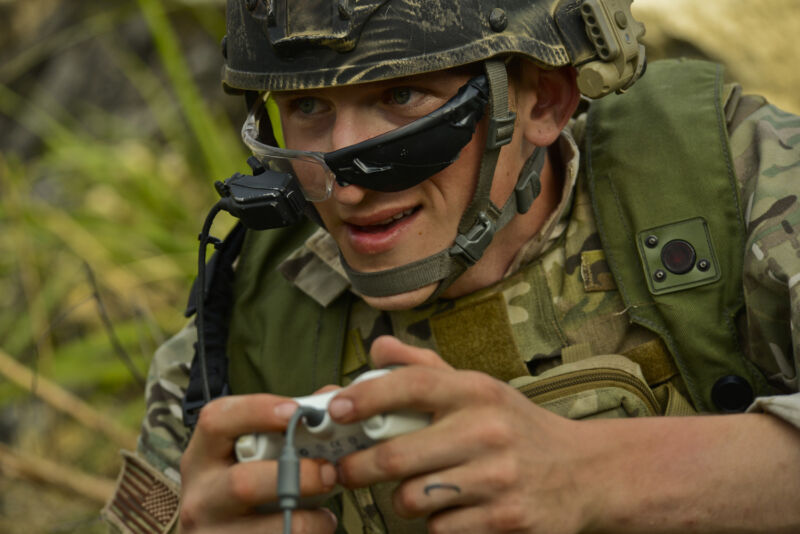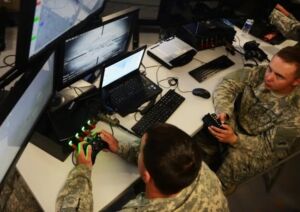
MRI analysis firm BodyViz, for instance, told the BBC that an Xbox controller provided a much more intuitive way to “rotate, pan, zoom or fly-through a patient's virtual anatomy” than the previously standard mouse-and-keyboard interface. And NASA has used an Xbox Kinect as an interface to control complex rovers like the six-limbed ATHLETE (All-Terrain Hex-Limbed Extra-Terrestrial Explorer).
But international militaries have shown some of the most avid and continued interest in adapting game-control interfaces for decidedly non-entertainment uses. In 2014, the US Navy was promoting its use of "a video game-like controller" in a laser weapon prototype, for example. And in 2018, the USS Colorado attack submarine was handing Navy sailors an Xbox controller to operate its periscope-like photonic masts.
Game controllers are also useful for remotely controlling complex military equipment in situations that could be unsafe for an on-site human pilot. In the UK, an "adapted Xbox controller" was used to remotely drive an off-road 4x4 in situations where improvised explosive devices (IEDs) were a concern. And a military partnership with Roomba-maker iRobot led to a line of bomb-disposal robots controlled by an Xbox controller.
A familiar, cheap control solution
One major advantage of these adapted game-control systems, according to those involved in implementing them, is user familiarity. iRobot Director of North American Products Tom Phelps told Business Insider in 2013 that they found great success replacing their IED disposal robot's original "puck-like controller" with the more familiar design of a standard Xbox controller.
"By 2006, games like Halo were dominant in the military," Phelps said. "So we worked with the military to socialize and standardize the concept... It was considered a very strong success, younger soldiers with a lot gaming experience were able to adapt quickly."
Military users presented with a familiar game controller "are far more willing to experiment, they are much less afraid of technology... it comes to them naturally," Israeli Colonel Udi Tzur told The Washington Post regarding a tank controlled with an Xbox controller. "It’s not exactly like playing Fortnite, but something like that, and amazingly they bring their skills to operational effectiveness in no time."
“They know exactly the position of those buttons, and they can reach much better performances with that system,” IAI Robotics General Manager Meir Shabtai told the Post. “The controller is just the interface, the whole idea is to present a sophisticated technology in a way they can deal with.”

Microsoft Elite Series 2 Wireless Controller for Xbox
Using control interfaces that have been perfected over decades by gaming companies can also be much cheaper than reinventing the wheel by designing a new control interface from scratch. "Gaming companies have spent millions to develop user-friendly graphic interfaces, so why not put them to work on UAVs [unmanned aerial vehicles]?" Raytheon Business Development Director Mark Bigham told Wired in 2008. "The video-game industry always will outspend the military on improving human-computer interaction."
"A lot of money gets invested into video game technologies so we can just piggyback on what they've done," NASA's Matt Clausen said at the 2012 Penny Arcade Expo.
Handheld game controllers can also sometimes be more comfortable than the bulky, heavy-duty joysticks specially built for military devices. Shabtai told The Washington Post that the "lighter and more portable" game controllers could be held in a lap in a way that fixed, mounted controls could not. These "off-the-shelf" controllers are also much cheaper to replace than custom control solutions that can cost thousands of dollars to produce, according to iRobot's Tim Trainer, a vice president at iRobot's Defense & Security business unit.
The merging of video game and military hardware has its detractors, though. The US military's drone program—which often uses game controllers—has been criticized by the UN and ACLU for creating a "PlayStation mentality" where "young military personnel raised on a diet of video games now kill real people remotely using joysticks." The pipeline from video games to the military has been analyzed in documentaries and in games themselves.Regardless, OceanGate Expeditions' use of a familiar game control interface might actually be one of the least surprising parts of the submersible's unorthodox design. As long as millions of gamers are using these controllers every day, other industries and organizations are going to take advantage of that familiar and well-tuned interface design for their non-gaming projects.
"interface" - Google News
June 21, 2023 at 07:38PM
https://ift.tt/9nfCbhj
Beyond missing Titanic sub, handheld gamepads are a common military interface - Ars Technica
"interface" - Google News
https://ift.tt/yiO8DKU
https://ift.tt/rEODeIm
Bagikan Berita Ini














0 Response to "Beyond missing Titanic sub handheld gamepads are a common military interface - Ars Technica"
Post a Comment